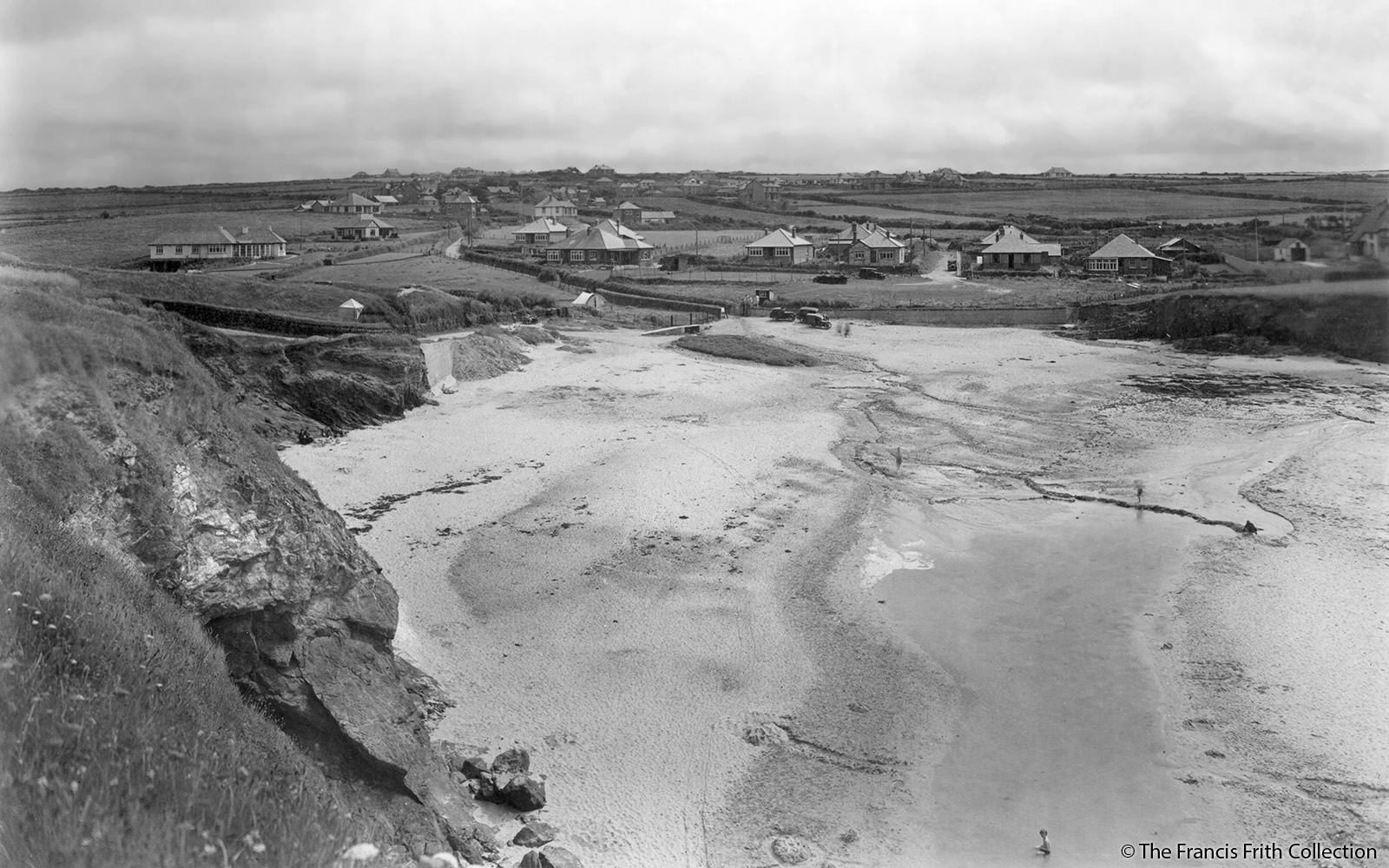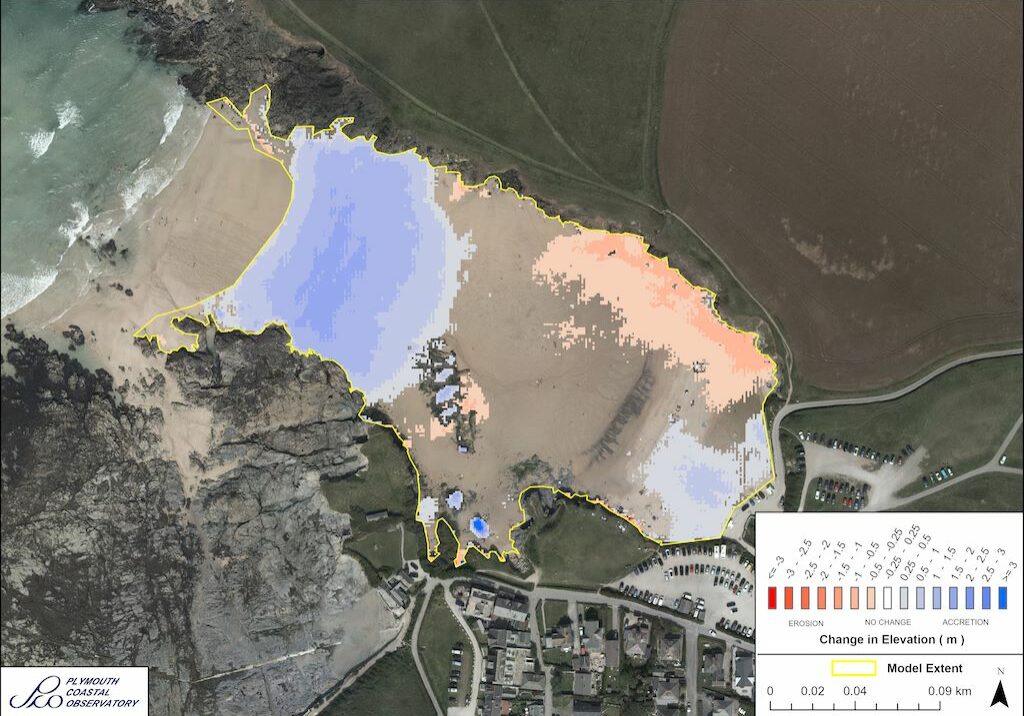
Trevone Bay, which is traditionally referred to as Porthmissen Beach (Cornish: ‘Baya Porthmusyn’, meaning ‘farm by the stream’) is a north-east facing wide cove in north Cornwall. The beach is located at the mouth of the Trevone Stream, which runs down the centre of the beach after first flowing down a short, largely agricultural, catchment.
Trevone Bay is a narrow and embayed beach of fine golden sand, fringed by low, steep cliffs and the rocky platforms of Pentonwarra Point to the south and Roundhole Point to the north. The uppershore of Trevone is dissected on the uppershore by a coastal road, which, in time, will increasingly suffer from damage from storms and coastal change.
The village of Trevone has developed on the southern side of the picturesque cove, with some less resilient sections of this cliff being reinforced with a variety of coastal protection features.
The archaeology of Trevone tells a rich story about the locations past. Under the sands of the beach is buried a submerged forest and a number of Bronze Age and Iron Age finds have been made in the open spaces surrounding the beach.


Coastal Change
The coastline of Cornwall is an ever-changing environment. It is energetic, dynamic, never still and changes with each wave and each tidal cycle. Some of the changes we see are gradual and barely noticeable, whilst others, such as rockfalls, happen suddenly and often shockingly.
From one visit to the next it can sometimes be difficult to see how a beach and dune system has changed, but information has been collected, and is being collected through the Making Space for Sand project, to help us better understand how the coastline is changing. The purpose of this section of the website is to understand each location has changed over time, how it could change in the future and understand the policies that influence how we can respond to these changes.
Shoreline Management Plan (SMP)
The Shoreline Management Plan (SMP) is a strategic planning and management assessment tool that helps identify and measure the risk associated coastal erosion and coastal flooding. The document makes a number of policy recommendations over short, medium and long term timeframes setting out a strategic approach to managing the built, natural and historic environments associated with the coastline. Within SMP there are four policy approaches which have been assigned to stretches of coastlines. The four policies are: No Active Intervention (NAI), Hold the Line (HTL), Managed realignment (MR), and Advance the line (ATL).
Trevone sits within Policy Development Zone 13 (PDZ13), in Management Area 34 (MA34), within Policy Unit (PU) 34.4. The policy recommendations for this policy unit are detailed in the table below and the SMP can be accessed through the Cornwall Council website.
Use your touchscreen
to scroll the below table
| Policy Unit | SMP2 Policy Plan | ||||
| 2025 | 2055 | 2105 | Comment | ||
| 34.1 | Undefended Cliffs
Main Policy Sub Policy
|
NAI DnD |
NAI DnD |
NAI DnD |
Will meet high level objectives and satisfy AONB and heritage coast criteria. Allow natural coastal evolution to occur to support conservation of designated features. |
| 34.3 | Trevone Cliffs
Main Policy Sub Policy
|
NAI LAO |
NAI LAO |
NAI LAO |
Present management is unsustainable, opportunity to return to naturally functioning section of coastline. NAI would not preclude private defences to be managed by landowners where appropriate. Little justification of protection due to very little amount of property at risk.
|
| 34.4 | Trevone Beach
Main Policy Sub Policy
|
MR P |
MR P |
NAI LAO |
MR will adapt frontage to impacts of climate change. Heavily defended frontage with no assets judged to be at risk. Long term policy intent is to NAI to provide consistency with Trevone Cliffs (34.3). MR policy is required in epochs 1 and 2 to allow realignment of facilities in the area. |
| Key Main Policy: HTL - Hold the Line, A - Advance the Line, NAI – No Active Intervention, MR – Managed Realignment
Sub Policy: DnD – Do not Defend, LAO – Local Activity Only, P – Placeholder.
|
|||||


National Coastal Erosion Risk Mapping (NCERM)
National Coastal Erosion Risk Mapping (NCERM) provides a baseline of coastal erosion, for the coastline of England, over short, medium and long-term timeframes. The data is based on the natural and defence characteristics of the coastline and provides rates of erosion at differing levels of confidence to help better plan for worse case scenarios. The data provided is for guidance and does not estimate the absolute location of the future coastline.
The basic NCERM lines show erosion estimates for the Short Term (ST-20 years), Medium Term (MT-50 years) and Long Term (LT- 100 years). The data is further categorised by probability: 05 is 5% probability (a 1 in 20 chance of being exceeded) Red Shading, 50 is 50% probability of being exceeded (a 1 in 2 chance of being either exceeded or not exceeded) Orange Shading and 95 is 95% probability (a 19 in 20 chance of being exceeded) Yellow Shading. Click the link below to access the Cornwall Council NCERM Mapping site read the about section then click on layers.

Historical Images of Trevone
Historical photographs provide a powerful insight into how the Cornish coastline has changed within the past Century. The Making Space for Sand project are working in collaboration with the Francis Firth collection and have been given permission to share historical images on a number of beaches considered within the project.
In looking back, we can better understand how the coastline has changed, helping us understand not only how the coastal fringe has developed but also the potential future changes that we my observe. When this is considered alongside forecasts of coastal erosion and sea level rise it will help enable us to better adapt to our changing coastline.

Trevone Bay/Porthmissen beach in 1925 (Image courtesy of the Francis Frith collection) and in 2023.

Modelling Coastal Change

Using data that has already been collected, combined with data collected through the Making Space for Sand project, a series of models will be carried out at each location. This will help us better understand how each location may respond to sea level rise and gain a deeper understanding of how coastal sediments move and behave.
The complexity of the modelling, and the data collection that helps inform it, means that modelling outputs will not be the same on all sites. Some locations will be more thoroughly investigated to understand more complex issues and provide data that can be more widely applied to other sites with similar characteristics.
As the project develops this section of the website will expand, sharing new reports and coastal change projections when they are produced.
LiDAR surveys, which are explained on the Data Modelling page, have been carried out by the South West Coastal Monitoring program at this location. The image shared here visualises where sand has eroded (areas shaded in red) and where it has built up (areas shaded in blue), between the LiDAR surveys carried out in 2003 and 2019. The darker the shade of red or blue the greater the amount of sand erosion or accumulation has been observed. The image helps visualise that beaches are areas that change shape over time and will continue to do so as sea levels rise.


Designations
The coastline represents an important transition between the marine environment and the terrestrial environment. This transition creates a range of special habitats and exposes a range of interesting features, which that can result in these spaces being highly designated and protected. There are a range of designations that recognise a variety of different features. At this location these designations are explored below.
Site of Special Scientific Interest (SSSI)
A Site of Special Scientific Interest or SSSI is a statutory conservation designation notified by Natural England denoting protection for biological and/or geological characteristics. The natural wildlife and geological features of SSSI’s are considered to be irreplaceable parts of the national heritage. These are protected in order to preserve their importance, and to prevent damage and development.
Image of the High Cliffs of North Cornwall (Courtesy of Coralie Barrow)
Trevone Bay SSSI
The Trevone Bay SSSI covers an area of 9.4 hectares between Porthmissen Bridge to the north and Newtrain Bay to the south. The folded and faulted geology of the area contains excellent exposures of fossil rich slates, which are important for dating purposes. The cliff face exposes a sequence of alternating marble, shale and limestone, rich in microfossils and the eastern side of Trevone Bay boasts a dolerite sill (a form of igneous volcanic rock) with a unique chemistry and mineral content rare not only in Cornwall but also in Europe.
Image of the spectacular coastline of North Cornwall
Designated Cornwall National Landscape Area
From November 2023, all areas previously know as Areas of Outstanding Natural Beauty, or AONBs, were re-named National Landscape and in Cornwall became Cornwall National Landscape. However, the Management Plan still references the term AONB as this was formally adopted by Cornwall Council and cannot be amended until the next plan is produced.
Cornwall National Landscape areas are protected landscapes whose distinctive character and natural beauty are so outstanding that it is in the nation’s interest to safeguard them. As such they have been nationally designated by the same legislation as National Parks and have the same status and level of protection.
The Carnewas to Stepper Point section covers an area of 2,365 hectares, which is 2.6% of the total Cornwall National Landscape. The key landscape characteristic of this section is the variety of coastal scenery due to the diverse geology including hard greenstones, which form the elevated headlands, the more easily eroded slates and shales that back the bays and coves between the headlands and the extensive coastal sand dunes.
Image of Bedruthan Steps
Marine Conservation Zone (MCZ)
A Marine Conservation Zone (MCZ) is a type of marine protected area, designated in English, Welsh and Northern Ireland territorial offshore waters, to protect a range of nationally important, rare or threatened marine habitats or species by halting or reversing damage and degradation caused by human activities.
The Padstow Bay and Surrounds MCZ covers an area of approximately 90 km2, extending from Park Head near Trenance to Com Head, just east of Pentire Point and The Rumps. The MCZ contains deeper water and intertidal rocky and sandy habitats home to a diversity marine creatures. In the more shallow waters large kelps and some smaller red seaweeds, that are capable of withstanding the powerful water surges, are able to flourish, whilst marine animals dominate the deeper water rocky habitats.
Image of an assortment of seaweeds (Courtesy of Susan Scott)
Sign up to Making Space for Sand
If you would like to get involved in helping to make dunes more resilient and biodiverse, want to help develop coastal adaptation and emergency plans or just want to know more about what the project is learning about coastal change, please click here:




